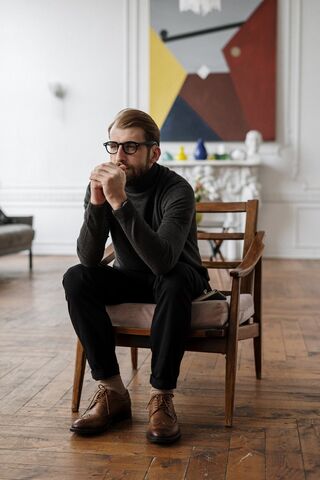Creativity
Creativity and Psychotherapy
The process of therapy is a mutually creative one.
Posted October 27, 2020 Reviewed by Kaja Perina
Treatment of illness through psychotherapy is a demanding task. All of us who practice this procedure experience serious demands and frustrations, but interestingly, we also have the sense of engaging in an especially worthy endeavor. What is there about the experience that gives us such a feeling? Surely, we are not merely grandiose professionals who have gathered together to carry out practices that feed our own self-esteem. Surely, we are not guided by quasi-religious or mystical beliefs that we try to impart to our patients. On the contrary, feeling that we practice without belief or illusion to any large degree, most of us pride ourselves in appraising reality well and avoiding excessive value judgments. Yet, something especially worthwhile seems to be occurring. The patient tells both him or herself and us this, often in an exaggerated way, but even after those exaggerations are evaluated and discounted, the feeling remains. It is an anticipation of experiencing this special worthiness that often carries us through the sometimes wearisome and frustrating hours, days, and years of difficult therapies.
We cannot rest on any laurels, however. Neither the difficulty nor the sense of worthiness justifies taking full satisfaction in our treatments as either excellently done or resulting in completely realized amelioration or cure. Long before psychotherapy was challenged by biochemical and neurobiological knowledge and advances, as it is today, there was a need to improve practice. No therapy used today can claim to be fully developed, either in theory or practice, and none can claim widespread effectiveness. Although there are surely many explanations available for this state of affairs, such as inadequate knowledge of the psychosocial biological bases of human development and behavior, as claimed by experimentalists and theorists, or inadequate use of certain approaches to patients or clients, as claimed by followers of particular schools or orientations, I shall here claim yet another one. I believe there is no theory of psychotherapeutic practice, systematically drawing on current psychological knowledge of development and behavior, that clearly points to areas requiring improvement. In short, there is no general conception of treatment that requires a therapist to perform at the highest level of which he is capable.
To describe the practice of psychotherapy that taps a therapist’s highest resources. I need first to address the paradox of a healing procedure based on scientific and objective precepts that incorporates strong moral and aesthetic values of personal dignity and freedom, respect for uniqueness and choice, and a certain emphasis on intuition and imagination. It appears that our best therapists have these paradoxical qualities; they are highly rigorous, consistent, and logical, and they also allow themselves free rein on their intuitiveness and imagination. They are scientific and rely on systematic data and theory, and they are aesthetic in their appreciation of intensity, narrative, interpretation, and leaps of understanding. To some extent this paradox is the bane of our psychotherapeutic existences. Because we value the aesthetic and humane side of psychic experience, and because we value intuitive understanding, we are accused of lacking scientific understanding. Indeed, we are accused of lacking any science at all. That this accusation is patently false in that there need be no canceling out of science in an aesthetic perspective, and the aesthetic perspective is amenable to systematic scientific study, analysis, and understanding.
The reason for the paradox, as well as the answer to the question about the sense of special worthiness of psychotherapy, is that the process of therapy is a mutually creative one. Let us assess the fundamental issue of normality. As we well know, the definition of psychological normality is very difficult. With so-called physiological normality and illness the definition seems much simpler and more clear-cut. When one contracts ordinary as well as Covid influenza with pneumonitis manifested by cough, sputum, and fever, neither one’s organs nor oneself is functioning. At that point, one is not normal. To be normal, it is necessary to return to the way one was before the flu. The deficiency must be corrected and then one will be “like everyone else”—lungs and person will function like the average or like the majority of persons and organs do. But with mental health and illness we will not accept this notion of the average or the majority as normal. Even in this country, which so strongly emphasizes democracy and equality, I believe that no one—neither patients nor therapists—would say that mental health is equivalent to being average or being the same as everyone else. Furthermore, returning to the average, or even to a previous state, may realistically not be sufficient for ameliorating mental illness. Once one has such an illness, almost invariably there are continued problems.
This also applies in a lesser way to physiological illness. After having a serious infectious disease, one is never—even after having stayed in bed, received medication, and eventually recovered—the way one was before. The diseased body area is permanently scarred. Such a scar is rather minuscule, but it is nevertheless a residuum for life. Everyone is permanently affected by every disease he has. With the bodily scar, of course, there is a deficiency, but it will not lead to recurrence of the disease unless there is further direct exposure to an infectious organism.

Psychologically, however, the problem of deficiency is both more insidious and more extensive, because patients (all human beings) are continually exposed to psychological dangers or threats comparable to invading organisms. In attempting to help someone return to functioning, much more is involved than for the doctor to administer penicillin. With the scar of mental illness, the person needs to be able to adapt better to his environment than before, and often to adapt better to his environment than others who have not been scarred. Growth is necessary for effective improvement.
Even if therapists did not often see things this way, patients would not allow them to think differently. Not only is it difficult with a particular patient to clarify the meaning of the therapeutic goal of helping him “function,” but the patient usually rejects such a term or such a goal out of hand. Nor do patients accept the aims of “coping” or “adjusting,” or even “adapting," very readily. They want to be better than they were, or better than others, and thereby able to deal with the constantly problematic environment human beings live in. In other words, both patients and therapists are oriented to, and engaged in, facilitating creation. The therapist uses the specific forms of creative cognition I have described here previously—janusian, homospatial, and sep-con articulation processes, and both are focused on the patient’s creation of aspects of his personality. Both are engaged in an ongoing mutual creative process that involves the patient’s personality attributes and personality structure.
By creation of personality attributes and structure, I mean something directly analogous to creation in the prototypical areas of the arts and sciences. As in the latter areas, there is also in psychotherapy the production of both the new and the valuable. The patient develops better personality attributes and structure—these are valuable both to the patient and to society at large. Moreover, these personality features are new to the patient because they result in part from a break with the past. Because they are unique to that individual, as all actively developed attributes intrinsically are, they are new to the world as well.
Psychotherapy, therefore, is intrinsically a mutual process of facilitating the creation of aspects of the patient’s personality, and the better the therapy the greater the degree of mutual creation. As therapists, we focus on the past, or on the present and future, because the past or elements from it have become restrictive for the patient. To the extent that the patient becomes free from the past, he is in a position to make new choices actively and to adopt new alternatives. As clear-cut aspects of the creative process, such choices are based in part on a sense or a knowledge of the effects of the past and thus are free of the restrictions of the past. But there is also a continuity with the past; the patient makes choices partly on the basis of what he knows or senses to be the determined and fixed aspects of himself. He accepts factors in his past that cannot, or need not, be changed.


